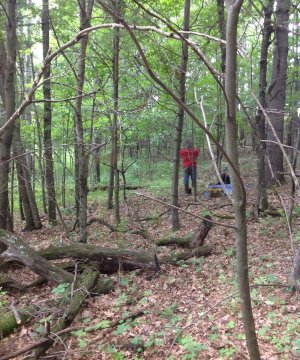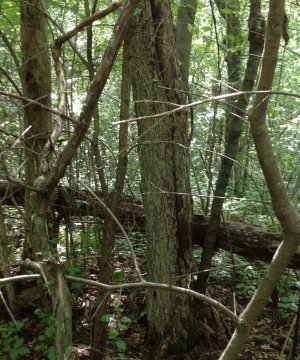Moist Clayey Lowland
Scenario model
Current ecosystem state
Select a state
Management practices/drivers
Select a transition or restoration pathway
-
Transition T1A
Stand replacing disturbance that includes fire.
More details -
Transition T1B
Removal of forest cover and tilling for agricultural crop production.
More details -
Restoration pathway R2A
Conifers slowly increase in abundance in the deciduous forest community.
More details -
Transition T2A
Removal of forest cover and tilling for agricultural crop production.
More details -
Restoration pathway R3A
Cessation of agricultural practices leads to natural reforestation, or site is replanted.
More details -
Transition T3A
Cessation of agricultural practices leads to natural reforestation, or site is replanted.
More details -
No transition or restoration pathway between the selected states has been described
Target ecosystem state
Select a state
Description
The reference plant community is categorized as mesic to wet-mesic forest community dominated by mixed deciduous species, primarily Sugar maple, Red maple, Basswood, Ashes, and Yellow birch. Several other associates including elms, oaks, and White birch may occur as well. White pine may be present in some stands as well. Shrub layers are usually poorly developed or altogether absent on this ES and may only contain gooseberries. Ground flora is likely to consist of ferns, jewelweed, hog peanut, wild geranium, virginia creeper, and sweet cicely. Although forest communities can vary greatly in terms of species composition and stand structure, depending on type, degree, and frequency of disturbance, two common phases predominate:
Submodel
Description
Post disturbance pioneer community of aspen and red maple with mixtures of other species from available seed sources (ashes, elms, white birch) are common in this state. This state can have broad variation depending on what seed sources are available as these sites readily supply water and nutrients in quantities that many species can thrive with. Depending on age and tree species composition the shrub and herb layer in this state can vary considerably. Namely with the dominance of aspen there is likely to be very little in the shrub layer.
Submodel
Description
Indefinite period of applying agricultural practices. Cropping systems vary on these sites and likely include tillage, row crops, hay or pasture, and specialty crops. Agricultural development of these sites could include drainage.
Submodel
Mechanism
Major stand-replacing disturbance. In pre-European settlement time, the event was most often a severe blow down, only very occasionally followed by fires on these sites due to wetness. Such blow downs have been estimated to occur in this part of Wisconsin every 300 to 400 years (Schulte and Mladenoff, 2005), but may have occurred more often on wet sites such as those in this ES. In post settlement virtually every acre has been logged either by clear cutting or successive cuts targeting species marketable at that time. These disturbances created the environment suitable for natural regeneration of many shade-intolerant species and for commercial planting. The history of cutting has lead many of these sites to be “swamped” as well leading to less Sugar maple in the Deciduous Forest State.
Mechanism
Removal of forest cover, tilling and application of other agricultural techniques to grow agricultural crops.
Mechanism
Conifers slowly increase in abundance in the deciduous forest community.
Mechanism
Removal of forest cover, tilling and application of other agricultural techniques to grow agricultural crops.
Mechanism
Abandonment of agricultural practices and allowing natural vegetation to colonize the site or apply artificial afforestation. The time required for forest community to reach the reference state conditions may exceed 100 years. This direct restoration pathway is likely slow and uncommon unless there has been drainage and adjacent seed sources exist.
Model keys
Briefcase
Add ecological sites and Major Land Resource Areas to your briefcase by clicking on the briefcase (![]() ) icon wherever it occurs. Drag and drop items to reorder. Cookies are used to store briefcase items between browsing sessions. Because of this, the number of items that can be added to your briefcase is limited, and briefcase items added on one device and browser cannot be accessed from another device or browser. Users who do not wish to place cookies on their devices should not use the briefcase tool. Briefcase cookies serve no other purpose than described here and are deleted whenever browsing history is cleared.
) icon wherever it occurs. Drag and drop items to reorder. Cookies are used to store briefcase items between browsing sessions. Because of this, the number of items that can be added to your briefcase is limited, and briefcase items added on one device and browser cannot be accessed from another device or browser. Users who do not wish to place cookies on their devices should not use the briefcase tool. Briefcase cookies serve no other purpose than described here and are deleted whenever browsing history is cleared.
Ecological sites
Major Land Resource Areas
The Ecosystem Dynamics Interpretive Tool is an information system framework developed by the USDA-ARS Jornada Experimental Range, USDA Natural Resources Conservation Service, and New Mexico State University.



